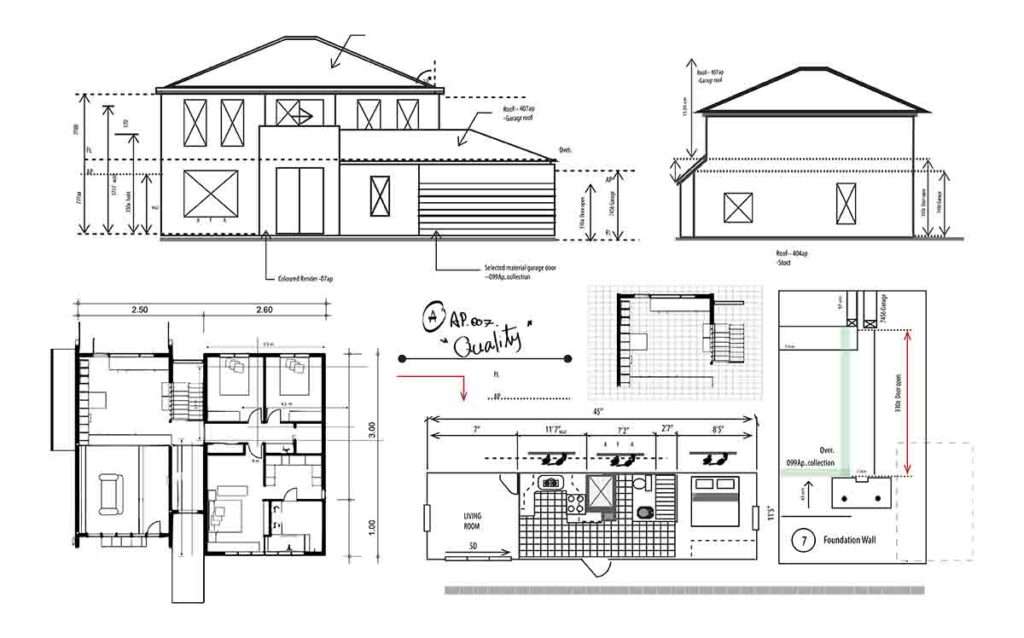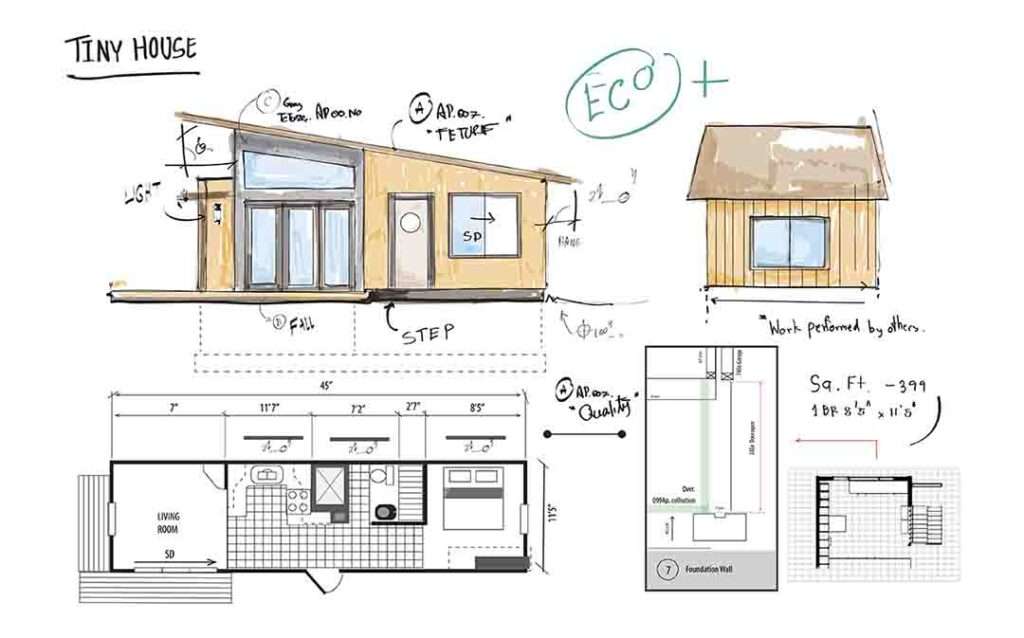From Basic to Advanced: Exploring Real Estate Floor Plans
Real estate floor plans are an essential tool for buyers and renters in the real estate industry. They provide an accurate representation of the layout of a property, including the size and arrangement of rooms, walls, doors, and windows. Real estate floor plans are a critical aspect of the buying and renting process, and they can help buyers and renters visualize the property and determine whether it meets their needs. This article will explore what a basic real estate floor plans is, the four types of floor systems, who can design a floor plan, why use floor plans for real estate, and what software is used to make floor plans.
Table of Contents
What is a basic floor plan?
A basic floor plan is a graphical representation of the layout of a property. It typically includes the size and arrangement of rooms, walls, doors, and windows. Basic floor plans provide an accurate representation of the property’s layout, which can help buyers and renters visualize the property and determine whether it meets their needs. Basic real estate floor plans are often used in the real estate industry to market properties and provide prospective buyers and renters with a visual representation of the property.

What are the 4 types of floor systems?
There are four main types of floor systems: slab-on-grade, basement, crawlspace, and suspended. Each type of floor system has its pros and cons, and the choice of floor system depends on a variety of factors, including the type of property, the location of the property, and the budget.
Slab-on-grade floor systems are typically used in warmer climates where the ground does not freeze. These systems are cost-effective and require little maintenance. However, they are not suitable for colder climates where the ground freezes.
Basement floor systems are typically used in colder climates where the ground freezes. Basements are typically constructed below ground level and provide additional living space. However, they can be expensive to construct and require regular maintenance to prevent water damage.
Crawlspace floor systems are typically used in areas where the ground is too rocky or too wet to support a slab-on-grade floor system. Crawlspace systems provide access to plumbing and electrical systems, but they can be difficult to access and require regular maintenance.
Suspended floor systems are typically used in areas where the ground is too soft to support a slab-on-grade floor system. These systems are typically constructed with a steel frame and a concrete slab. They are more expensive than other types of floor systems but provide additional space for storage and parking.
Who can design a floor plan?
Several professionals can design a floor plans for real estate, including architects, designers, and engineers. Each professional has its areas of expertise and can provide different levels of detail in their floor plans. Architects are trained to design buildings and can provide a comprehensive design that takes into account the structural, mechanical, and electrical components of the building. Designers can provide a more aesthetically focused design and can help with color selection, furniture placement, and other interior design elements. Engineers can provide a detailed analysis of the structural components of the building and can ensure that the building meets local building codes.
When choosing a professional to design a floor plan, it’s essential to consider their expertise, experience, and reputation. It’s also essential to ensure that the professional is licensed and insured and has a portfolio of previous work that demonstrates their ability to design floor plans.

Why use floor plans for real estate?
There are many advantages to using floor plans in real estate transactions. Below are some of the key benefits:
- Helps buyers visualize the property: A real estate floor plans provides a clear representation of the layout of a property, including the size and arrangement of rooms, walls, doors, and windows. This helps buyers to better visualize the property and get a sense of how it would function for their needs. In many cases, a floor plan can help a buyer to decide whether or not to visit a property in person, which can save time and effort for both the buyer and the seller.
- Provides accurate measurements: real estate Floor plans typically include measurements of each room, which can help buyers to get an accurate sense of the size and scale of the property. This can be especially useful for buyers who are looking to furnish the property or make other modifications based on the space available.
- Helps to identify potential issues: A real estate floor plans can help to identify potential issues with the layout of a property. For example, a poorly designed floor plan may make it difficult to navigate the space or create awkward living areas. By reviewing a floor plan, buyers can identify these issues before they make an offer on the property.
- Enhances marketing efforts: Including a floor plan in marketing materials can make a property stand out from the competition. Buyers appreciate the transparency and attention to detail that comes with providing a floor plan and are more likely to consider a property that includes one.
- Helps with renovations and remodeling: If a buyer is considering making renovations or remodeling a property, a floor plan can be a useful starting point. By reviewing the existing floor plan, buyers can identify areas where changes may be needed and develop a plan that meets their specific needs.
Real-life examples of how real estate floor plans have helped buyers make informed decisions:
- A family was looking to purchase a home but was concerned about the layout of the property. By reviewing the floor plan, they were able to see that the living areas were all located on one side of the house, while the bedrooms were on the other. This would have made it difficult for the family to monitor young children while they were in the living areas. As a result, they decided not to make an offer on the property.
- A couple was considering purchasing a condo, but were unsure about how they would furnish the space. By reviewing the floor plan, they were able to see that the living room was larger than they had initially thought, which gave them the confidence to make an offer on the property.

What software is used to make floor plans?
A. Overview of popular software used to create real estate floor plans
There are various software options available for creating real estate floor plans. Here are some of the most popular ones:
AutoCAD
AutoCAD is software used for 2D and 3D design and drafting. It is commonly used in the architecture, engineering, and construction industries. AutoCAD has a wide range of tools and features that allow users to create precise and detailed floor plans.
SketchUp
SketchUp is a user-friendly 3D modeling software that is widely used in the architecture, design, and construction industries. It has a simple interface that makes it easy to create 3D models and floor plans. SketchUp also has a large library of pre-built 3D models and a supportive online community.
Sweet Home 3D
Sweet Home 3D is a free, open-source software that allows users to create 2D and 3D floor plans. It is easy to use and has a wide range of features, such as the ability to import furniture models and create virtual tours of
Floorplanner
Floorplanner is a web-based software that allows users to create floor plans and 3D models. It has a drag-and-drop interface that makes it easy to create floor plans quickly. Floorplanner also has a large library of furniture models and a 3D rendering feature that allows users to create realistic virtual tours of properties.
B. Comparison of the features and functionalities of each software
AutoCAD is a powerful software that is ideal for creating detailed and precise real estate floor plans. However, it has a steep learning curve and may not be suitable for beginners or small businesses with limited budgets.
SketchUp, on the other hand, is easy to use and has a large online community that offers support and resources. It also has a free version that is suitable for small businesses or individuals with limited budgets.
Sweet Home 3D is free software that offers a wide range of features and tools. It is easy to use and has a large library of furniture models. However, it may not be as powerful as AutoCAD or SketchUp and may not be suitable for creating complex real estate floor plans.
Floorplanner is a web-based software that is easy to use and offers a wide range of features. It has a large library of furniture models and a 3D rendering feature that allows users to create realistic virtual tours of properties. However, it may not be as powerful as AutoCAD or SketchUp and may not be suitable for creating complex floor plans.
C. Tips for choosing the right software for your needs
When choosing software for creating real estate floor plans, it is important to consider your specific needs and budget. Here are some tips to help you choose the right software:
Experience
If you are new to creating floor plans, it may be best to choose software with a user-friendly interface, such as SketchUp or Sweet Home 3D.
Budget
Some software options, such as AutoCAD, can be expensive. If you have a limited budget, consider a free or low-cost option, such as Sweet Home 3D or Floorplanner
Features
Different software options offer different features and tools. Consider what features you need, such as 3D rendering or a large library of furniture models, and choose a software that meets those needs.
Support and resources
Some software options, such as SketchUp, have a large online community that offers support and resources. Consider the support and resources available when choosing software.
Conclusion
In conclusion, real estate floor plans are an essential tool for the real estate industry. They help buyers and renters visualize the layout of a property and make informed decisions. A basic floor plan consists of several key components, including the size and arrangement of rooms, walls, doors, and windows. There are four types of floor systems, each with its pros and cons, and various professionals can design floor plans, depending on the needs of the project.
Floor plans are essential for real estate transactions as they provide accurate measurements and help buyers and renters to determine whether the property meets their needs. They can be easily shared online and provide an excellent marketing tool for real estate agents and property owners. The software used to make floor plans has advanced over the years, and there are various options available, depending on the user’s needs.
Overall, whether you are buying, renting, or selling a property, a real estate floor plans is an essential tool to have. It provides a clear and accurate representation of the property’s layout and helps to avoid any confusion or misunderstandings during the buying or renting process. As the real estate industry continues to evolve, the importance of floor plans will only continue to grow.

[…] plans, provide a list of the top free software for creating floor plans, a step-by-step guide on how to create a floor plan for free, and answer some frequently asked […]